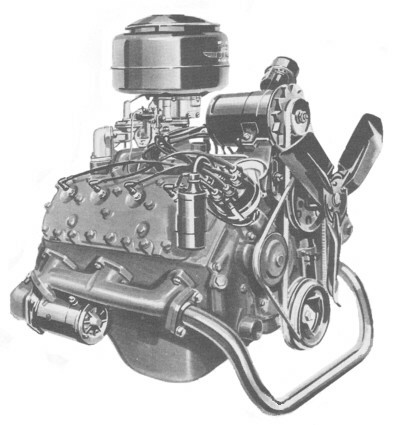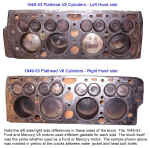|
Flathead V8 Specifications Late Style 90 to 125hp |
|||||||||||||||||||||||||||||||||||||||||||||||||||||||||||||||||||||||||||||||||||||||||
|
|
|||||||||||||||||||||||||||||||||||||||||||||||||||||||||||||||||||||||||||||||||||||||||
|
Home Parts Drawings Web Links Tune-Up & Service Serial Numbers Engine ID Trans ID Model Identification Terms of Sale Contact Us Our Online Store Our Catalog |
Late 90-125hp V8: 1949 to 1953 Passenger Cars 1948 to 1953 Trucks |
||||||||||||||||||||||||||||||||||||||||||||||||||||||||||||||||||||||||||||||||||||||||
|
The Strato-Star
EAB V8 for 1953 |
Major changes occurred to the mid size flathead V8 in 1948 for the new Ford trucks and in 1949 for new Ford and Mercury cars. The new engine incorporated several changes, some obvious and some not. The heads are now bolted to the blocks with 24 bolts (rather than studs and nuts) and the water outlet fittings are moved up to the front corner of the head (rather than the middle of the head). Another major change was the use of the new "Load-A-Matic" distributor, which was driven off the front of the engine, but through a shaft mounted vertically at right angle to the axis of the engine. With this new engine, Ford stopped casting the bell housing integral to the cylinder block, and provided it as a separate component which was bolted on. Internal changes include using a straight stem valve with one-piece valve guide. The belts and pulleys for 1948/49 stayed with the 5/8" wide of previous years, but changed to the narrow belts for 1950-53 passenger car engines. The truck engines stayed with the wide belts through 1952 types. In general, the latter year flatheads were commonly referred to as the "8BA" type for Ford and "8CM" for Mercury. The truck version was identified as an "8RT". Later 1952 and '53 Fords and Mercurys were known as "EAB" and "EAC" respectively. These markings are generally cast into the cylinder heads. The truck versions often had different oil pans to accommodate the different suspensions, and some truck V8's were factory "relieved". The EAB's and EAC's did not have the hardened valve seat inserts like the earlier engines. | ||||||||||||||||||||||||||||||||||||||||||||||||||||||||||||||||||||||||||||||||||||||||
Mercury engines were green in color from 1949 through 1951. From 1952 to 1953 they were either green or tangerine. For complete crankshaft bearing specs CLICK HERE. Keep in mind that there were exceptions to these guidelines. Also,
remanufactured engines and rebuilt engines of another color could have |
|||||||||||||||||||||||||||||||||||||||||||||||||||||||||||||||||||||||||||||||||||||||||
|
The 1949 to 53 engine blocks were all essentially the same. The primary difference being that Ford installed replaceable hardened valve seat inserts (exhaust side only) on the 1949 to 51 engines. The 1952-53 models did not come from the factory with any hardened valve seat inserts, although they are often found with them now, having had them installed by an engine rebuilder at some time later on. Click on the picture above for an enlarged view of the tops of the cylinders. |
|||||||||||||||||||||||||||||||||||||||||||||||||||||||||||||||||||||||||||||||||||||||||


